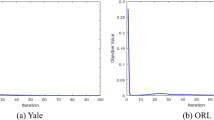Abstract
Linear discriminant analysis (LDA) is a well-known feature extraction method, which has been widely used for many pattern recognition problems. However, the objective function of conventional LDA is based on L2-norm, which makes LDA sensitive to outliers. Besides, the basis vectors learned by conventional LDA are dense and it is often hard to explain the extracted features. In this paper, we propose a novel sparse L1-norm-based linear discriminant analysis (SLDA-L1) which not only replaces L2-norm in conventional LDA with L1-norm, but also use the elastic net to regularize the basis vectors. Then L1-norm used in SLDA-L1 is for both robust and sparse modelling simultaneously. We also propose an efficient iterative algorithm to solve SLDA-L1 which is theoretically shown to arrive at a locally maximal point. Experiment results on some image databases demonstrate the effectiveness of the proposed method.










Similar content being viewed by others
References
Ahonen T, Hadid A, Pietikäinen M (2006) Face description with local binary patterns: Application to face recognition. IEEE Trans Pattern Anal Mach Intell 28(12):2037–2041
Bair E, Hastie T, Paul D, Tibshirani R (2006) Prediction by supervised principal components. J Am Stat Assoc 101(473):119–137
Barshan E, Ghodsi A, Azimifar Z, Jahromi MZ (2011) Supervised principal component analysis: Visualization, classification and regression on subspaces and submanifolds. Pattern Recogn 44(7):1357–1371
Belhumeour PN, Hespanha JP, Kriegman DJ (1997) Eigenfaces vs. Fisherfaces: Recognition using class specific linear projection. IEEE Trans Pattern Anal Mach Intell 19(7):711–720
Cai D, He X, Han J (2007) Spectral regression: a unified approach for sparse subspace learning. Proceeding of the 2007 International Conference on Data Mining (ICDM 07), Omaha, NE, 73–87
Cai D, He X, Han J (2008) Sparse projections over graph. Proceedings of the 21st AAAI conference on artifician intelligence
Ding C, Zhou D, He X, Zha H (2006) R1-PCA: Rotational invariant L1-norm principal component analysis for robust subspace factorization. Proceedings of the 23rd Internal Conference on Machine Learning, 281–288
Duda RO, Hart PE, Stork DG (2000) Pattern Classification, 2nd edn. John Wiley & Sons, New York
Fukunaga K (1990) Introduction to Statistical Pattern Recognition, 2nd edn. Academic Press, Boston, USA
Gu B, Sheng VS (2016) A robust regularization path algorithm for ν-support vector classification. IEEE Trans Neural Netw Learn Syst. https://doi.org/10.1109/TNNLS.2016.2527796
Gu B, Sheng VS, Tay KY, Romano W, Li S (2015) Incremental support vector learning for ordinal regression. IEEE Trans Neural Netw Learn Syst 26(7):1403–1416
Gu B, Sheng VS, Wang Z, Ho D, Osman S, Li S (2015) Incremental learning for ν-support vector regression. Neural Netw 67(7):140–150
Gu B, Sun X, Sheng VS (2016) Structural minimax probability machine. IEEE Trans Neural Netw Learn Syst. https://doi.org/10.1109/TNNLS.2016.2544779
Jain AK, Duin RPW, Mao J (2000) Statistical pattern recognition: A review. IEEE Trans on Pattern Analysis and Machine Intelligence 22(1):4–37
Jenatton R, Obozinski G, Bach F (2010) Structured sparse principal component analysis. Proceeding of the 13th international conference on artificial intelligence and statistics, 366–373
Kawulok M, Wu J, Hancock ER (2011) Supervised relevance maps for increasing the distinctiveness of facial images. Pattern Recogn 44(4):929–939
Ke Q, Kanade T (2005) Robust L1 norm factorization in the presence of outliers and missing data by alternative convex programming, Proc IEEE Conf Comput Vis Pattern Recognit, San Diego, CA, USA, 20-26 June, vol. 1, p 1-8
Kwak N (2008) Principal component analysis based on L1-norm maximization. IEEE Trans on Pattern Anal Mach Intell 30(9):1672–1680
Leng L, Zhang J, Xu J, Khan MK, Alghathbar K (2010) Dynamic weighted discrimination power analysis in DCT domain for face and palmprint recognition. Int Conf Inf Commun Technol Convergence:467–471
Leng L, Zhang J, Khan MK, Chen X, Alghathbar K (2010) Dynamic weighted discrimination power analysis: A novel approach for face and palmprint recognition in DCT domain. Int J Phys Sci 5(17):2543–2554
Leng L, Zhang J, Chen G, Khan MK, Alghathbar K (2011) Two-directional two-dimensional random projection and its variations for face and palmprint recognition. Int Conf Comput Sci Appl, Santander, Spain, June 20-23, p 458–470
Li H, Jiang T, Zhang K (2004) Efficient and robust feature extraction by maximum margin criterion. Advances in Neural Information Processing Systems, Cambridge, MA, 97-104
Li H, Jiang T, Zhang K (2006) Efficient and robust feature extraction by maximum margin criterion. IEEE Trans Neural Netw 17(1):1157–1165
Li X, Hua W, Wang H, Zhang Z (2010) Linear discriminant analysis using rotational invariant L1 norm. Neurocomputing 13-15(73):2571–2579
Meng D, Zhao Q, Xu Z (2012) Improve robustness of sparse PCA by L1-norm maximization. Pattern Recogn 45(1):487–497
Nie F, Huang H, Ding C, Luo D, Wang H (2011) Principal component analysis with non-greedy L1-norm maximization. The 22nd International Joint Conference on Artificial Intelligence (IJCAI), Barcelona, 1-6
Pang Y, Li X, Yuan Y (2010) Robust tensor analysis with L1-Norm. IEEE Trans Circuits Syst Video Technol 20(2):172–178
Wang H (2012) Structured sparse linear graph embedding. Neural Netw 27:38–44
Wang H, Wang J (2013) 2DPCA with L1-norm for simultaneously robust and sparse modelling. Neural Netw 46(10):190–198
Wang H, Tang Q, Zheng W (2012) L1-norm-based common spatial patterns. IEEE Trans Biomed Eng 59(3):653–662
Wang H, Lu X, Hu Z, Zheng W (2014) Fisher discriminant analysis with L1-norm. IEEE Trans Cybernetics 44(6):828–842
Wen X, Shao L, Xue Y, Fang W (2015) A rapid learning algorithm for vehicle classification. Inf Sci 295(1):395–406
Xia J, Chanussot J, Du P, He X (2014) (Semi-) supervised probabilistic principal component analysis for hyperspectral remote sensing image classification. IEEE J Sel Top Appl Earth Observations Remote Sens 7(6):2224–2236
Xuelong L, Pang Y, Yuan Y (2009) L1-Norm-Based 2DPCA. IEEE Trans Syst Man Cybern B Cybern 40(4):1170–1175
Yan S, Xu D, Zhang B, Zhang H-J, Yang Q, Lin S (2007) Graph embedding and extensions: A general framework for dimensionality reduction. IEEE Trans Pattern Anal Mach Intell 29(1):40–51
Yang J, Zhang D, Frangi AF, Yang JY (2004) Two-dimensional PCA: A new approach to appearance-based face representation and recognition. IEEE Trans Pattern Anal Mach Intell 26(1):131–137
Zhao G, Pietikäinen M (2007) Dynamic texture recognition using local binary patterns with an application to facial expressionas. IEEE Trans Pattern Anal Mach Intell 29(6):915–928
Zheng W, Lin Z, Wang H (2014) L1-norm kernel discriminant analysis via Bayes error bound optimizatin for robust feature extraction. IEEE Trans Neural Netw Learn Syst 25(4):793–805
Zhong F, Zhang J (2013) Linear discriminant analysis based on L1-norm maximization. IEEE Trans Image Process 22(8):3018–3027
Zhou H, Hastie T, Tibshirani R (2006) Sparse principal component analysis. J Comput Graph Stat 15(2):265–286
Zhou T, Tao D, Wu X (2011) Manifold elastic net: A unified framework for sparse dimension reduction. Data Min Knowl Disc 22:340–371
Zhou Z, Wang Y, Wu QMJ, Yang C-N, Sun X (2016) Effective and efficient global context verification for image copy detection. IEEE Trans Inf Forensics and Secur. https://doi.org/10.1109/TIFS.2016.2601065
Acknowledgments
This research is supported by supported by NSFC of China (No. 61572033, 71371012), the Natural Science Foundation of Education Department of Anhui Province of China (No.KJ2015ZD08), the Social Science and Humanity Foundation of the Ministry of Education of China (No. 13YJA630098).
Author information
Authors and Affiliations
Corresponding author
Rights and permissions
About this article
Cite this article
Lu, GF., Zou, J., Wang, Y. et al. Sparse L1-norm-based linear discriminant analysis. Multimed Tools Appl 77, 16155–16175 (2018). https://doi.org/10.1007/s11042-017-5193-9
Received:
Revised:
Accepted:
Published:
Issue Date:
DOI: https://doi.org/10.1007/s11042-017-5193-9





